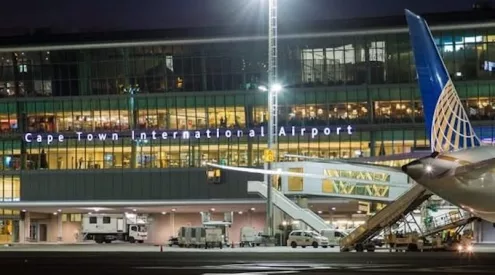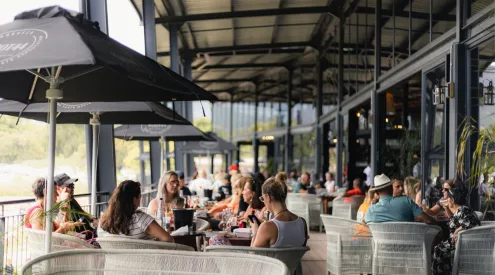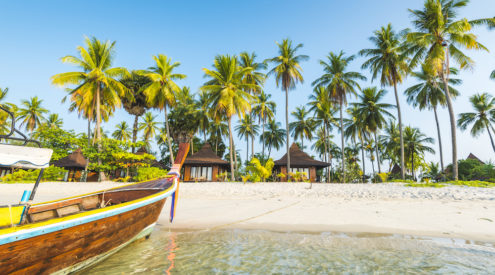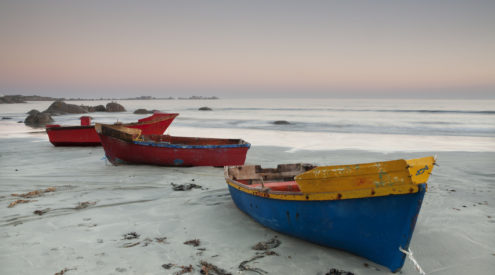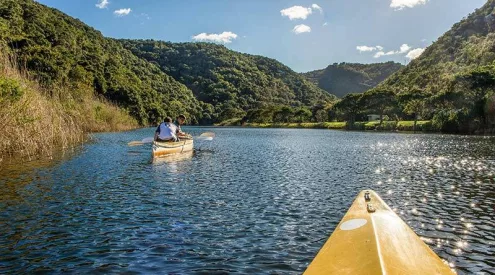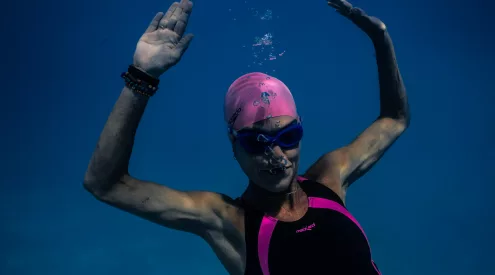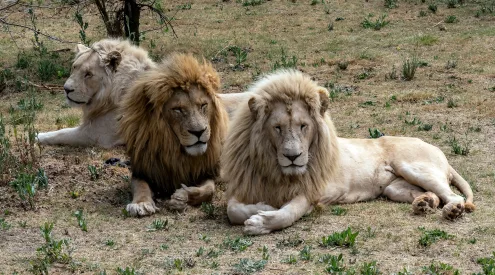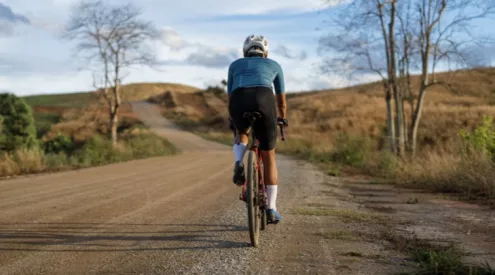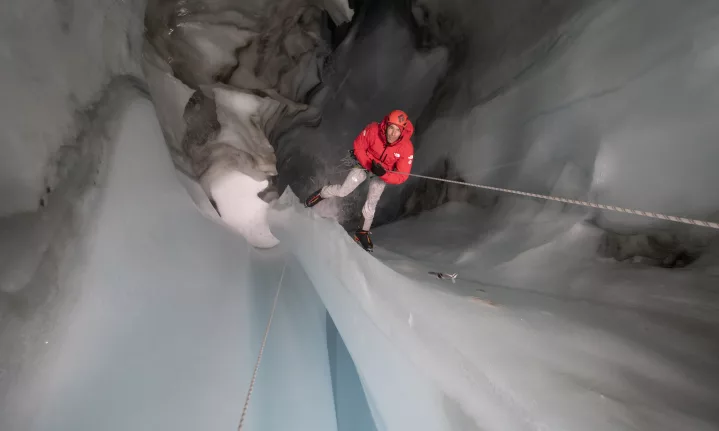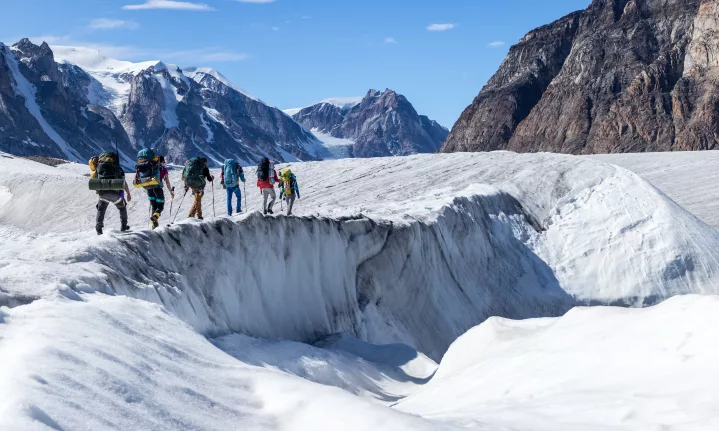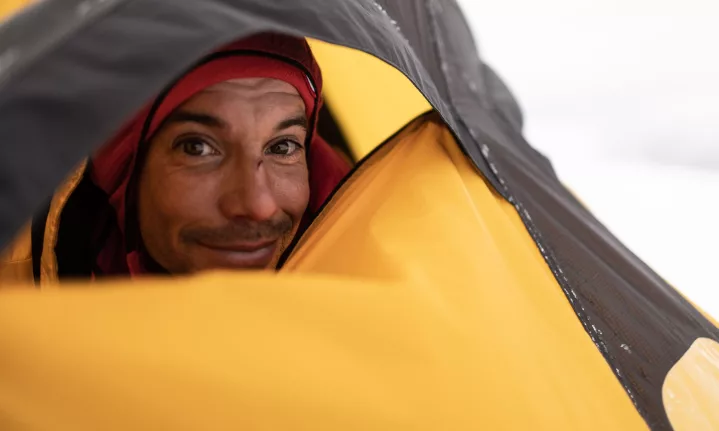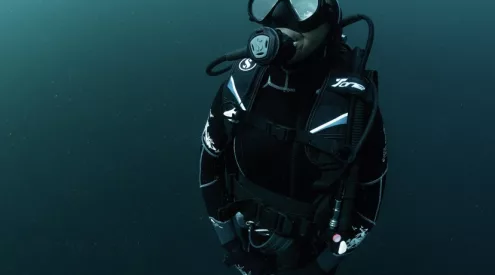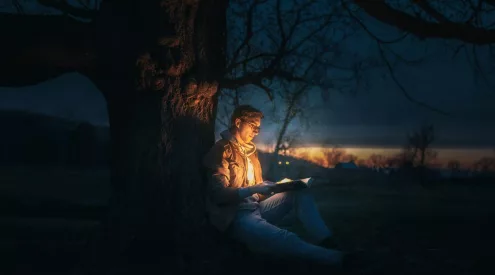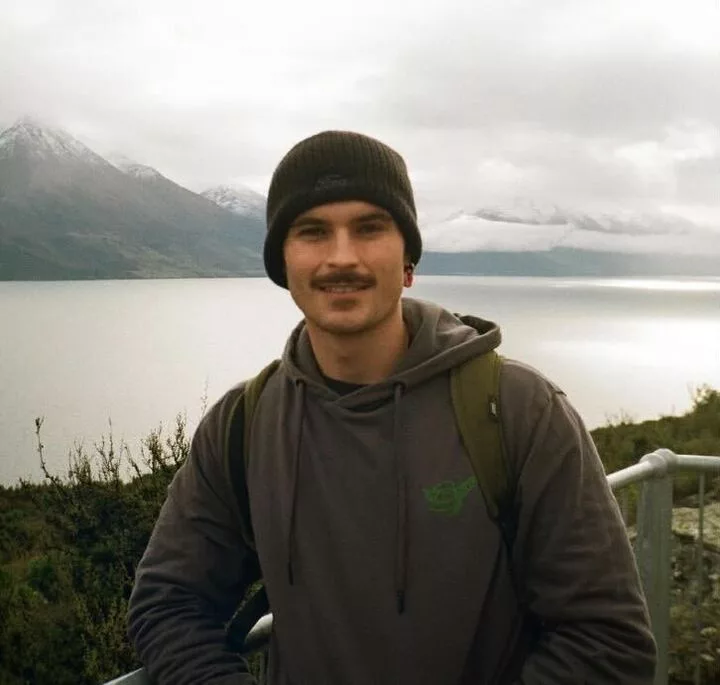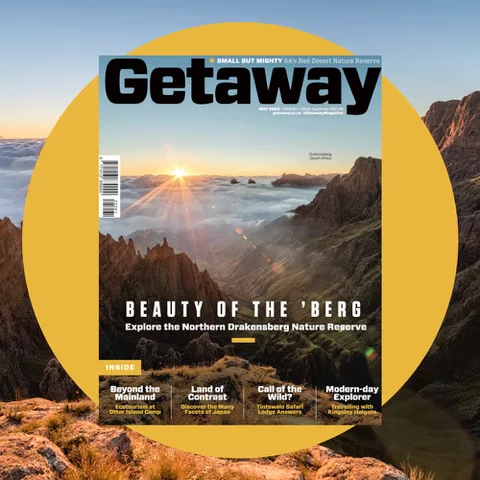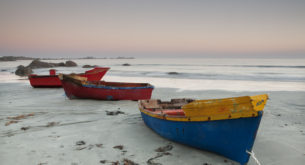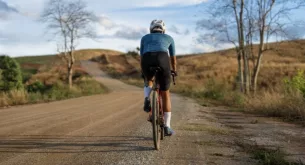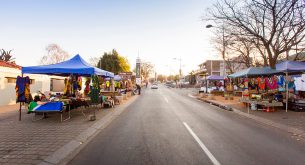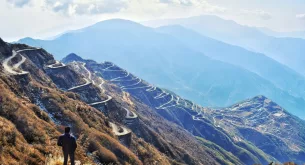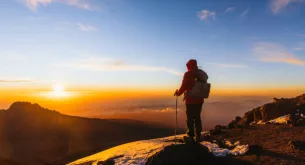It’s taken more than three weeks, but we’ve finally reached our main objective: Ingmikortilaq (‘the separate one’ in Greenlandic), nearly three times the size of the Empire State Building.
I don’t know your definition of adventure, but it’s hard to imagine anything more intrepid than an unclimbed 1 143 m wall with icebergs floating below.
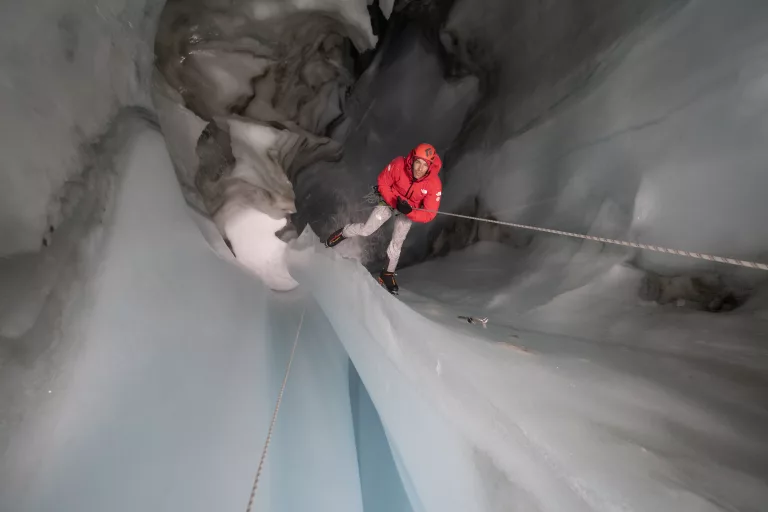
Alex Honnold in a moulin. (photo credit: National Geographic/Mikey Schaefer)
The icebergs have gotten prettier, and the reflections on the mountains more beautiful. We still have a good 425 m between us and the summit. We’re travelling light with limited supplies. There is no plan B; we’re going to the top. Two pitches later, we finally begin the most challenging part of the climb, the head wall.
The whole mountain is like a stack of cards, blocks teetering on top of each other, and it feels like if any of them goes, they’ll all crumble. On this wall, there are hardly any points where you feel safe. We’re constantly on edge.
For hours, we slowly ascend, not really knowing if we’ll hit a dead end. The most important thing for me is staying in the moment, focusing on the wall, making one move at a time, not thinking about what might happen.
I’ve never been so happy to get to the top of something. I’m so psyched! It’s awe-inspiring to see one of Greenland’s most vast, active glaciers shedding massive icebergs into the fjord below. It’s one of those things you must see to believe. Neither UK-based climber Hazel Findlay nor I have ever climbed anything so consistently scary, but it does feel like we’ve gotten away with something. You can only roll the dice so many times. It’s the sort of climb you only do if it matters enough to you.
The Beginning
I’ve spent most of my life rock climbing, and I’m best known for being the first person to free solo* El Capitan, a 914 m wall in Yosemite National Park [on 23 June 2017. It took him three hours and 56 minutes].
Growing up in Sacramento, California, I was a shy child with a dark soul, perhaps melancholic. I remember playing with Lego and computer games, and then once I started rock climbing, I went to a climbing gym. I didn’t have many hobbies or interests.
I recall when I started climbing outside more, road tripping and going to campgrounds. But I was too afraid to talk to strangers, so I did a lot of free soloing, climbing alone because I didn’t know or want to talk to anybody.
No one in my family hugged me during my formative years. I had to teach myself how to hug when I was 23. I was like, everybody seems to hug, maybe that’s something I should get into, and I started practising.
No one in my family ever used the word love. My mom only spoke French to my sister and me. She’s a French teacher, so she’d say, ‘Je t’aime’. And my dad didn’t talk about anything. I always saw him as a teddy bear, but he was morose. After my parents divorced, they seemed happier. He died the following summer when I was 19. It’s too bad he didn’t see how it all played out because he put so much effort into my climbing.
Maybe Mom thought he wasn’t pushing us hard enough to achieve stuff. Her favourite sayings were ‘almost doesn’t count’ and ‘good enough isn’t good enough’. No matter how well I did anything, it wasn’t that good. I was in the bottomless pit of self-loathing.
ALSO READ: Not Alone
Pursuing Perfection
Nurture, not nature, led me to free solo El Capitan. My parents are professors, and none of my family have an aptitude for sports. I’ve always loved climbing enough to do it five or six days a week for many years and not get tired of it. If you love doing something, but you also feel like you want to be good at it because you’re doing it all the time, eventually, you get better at it.
Free soloing has always been a small percentage of my climbing. I see it as my World Cup, my one big annual event to test myself. If you spend your whole life training, you want to test yourself to see if it’s working.
There’s been a lot of speculation about how I handle fear and can free solo. People think I’m a thrill-seeker, defective.

Alex Honnold peering out of his tent at the Pool Wall base camp. (photo credit: National Geographic/Pablo Durana)
The biggest challenge is not controlling your fear but stepping outside it. People talk about suppressing fear, but I look at it differently. I try to expand my comfort zone by practising moves repeatedly. I work through fear until it’s not scary anymore.
I like to differentiate between risk and consequence. I like to think the chance of me falling off is low, even though the consequences are high. One of the appeals of free soloing is to take something that seems risky and make it feel safe.
I don’t want to fall off and die, but there’s satisfaction in challenging yourself and doing something well. That feeling is heightened when you’re facing death. You can’t make a mistake. If you’re seeking perfection, free soloing is as close as you can get. It feels good to feel perfect for a moment.
When Dad died, I quit school and stole the family minivan. He had life insurance, just enough to dirtbag**, so I used the money to spend more than a decade living in a van, chasing the best climbing conditions. I’d park in a supermarket car park and spend 88 cents on dinner. I met my wife, Sanni McCandless, when I was book touring in Seattle, and we bought a home in Las Vegas just before my first ascent of El Capitan. My relationship with Sanni is the most stable I’ve ever had, certainly more communicative. We have a daughter, June, born in early 2022.
Beyond the Wall
Climbing allowed me to travel internationally, which opened my eyes to how the rest of the world lives. One billion people on Earth don’t have access to power. So, the first year I started earning more than I needed, I set up The Honnold Foundation and started donating one-third of my income to help fund solar projects that lift people out of poverty and help the environment.
If the Greenland ice sheet were to melt due to climate change, sea levels would rise by about seven metres, causing devastation to the billions who live along the world’s coast. We frequently see weather- and climate-related news about places experiencing the hottest month ever recorded. But nobody mentions the Arctic has warmed nearly four times faster than the rest of the world over the past 43 years.
It’s not as if I want to be an explorer. I’ve always been a rock climber at heart, but in the case of the expedition to Greenland, to go where no one’s ever been before and help glaciologist Dr Heïdi Sevestre gather critical scientific data about how glaciers and ice sheets react to climate change in places no one’s been able to get to before…that opportunity is rare.
Dr Sevestre described it as like being an astronaut on NASA’s International Space Station (ISS). Because individual universities can’t afford to send someone to the middle of nowhere in Eastern Greenland, she was conducting experiments for numerous institutions worldwide. My role was helping her execute her experiments.
My usual climbing routine had already physically prepared me for the expedition. It was more about ensuring we had the right equipment, the right kind of skis, sleds, jackets and tents for a remote environment.
Greenland is an island in the north Atlantic almost entirely covered by a vast sheet of ice, in some places up to 3.2 km thick. It’s a fantasy landscape straight out of J. R. R. Tolkien’s The Hobbit, so big, so wild.
Arctic Ascent with Alex Honnold was an opportunity to help people understand how beautiful and almost magical Eastern Greenland is, but also how relatively fragile it is and how much of an impact it will have on the rest of the world if or when it melts. All models show it melting over the next 50 years, it’s happening, so educating people about it is crucial.
The Expedition
To reach Ingmikortilaq, we had to be the first to cross the Renland Ice Cap. But to get there, we first had to complete a two-day climb up what we called the Pool Wall, a 152 m, unclimbed Arctic cliff. To reach the summit, we had to get through the steep top section of the wall. We only had thin cracks to follow, plus the rock was constantly crumbling. My fingers hurt; they were numb and bleeding.
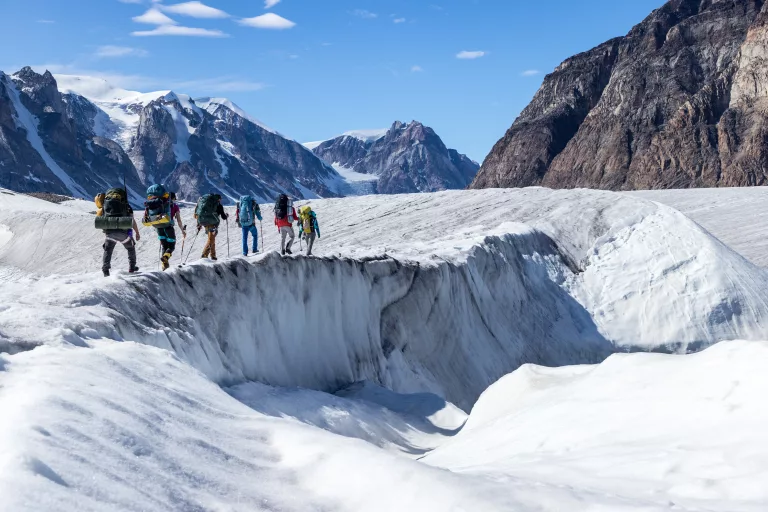
Alex and the team walk up Edward Bailey Glacier. (photo credit: National Geographic/Matt Pycroft)
Finally, we made it onto the Renland Ice Cap, a 68-km-wide reservoir of ice, some of which has existed for tens of thousands of years. It was the highest, coldest part of our expedition, and we skied northwest, taking measurements for Dr Sevestre’s research.
Then, we descended the glacier into the fjord below. We’d spent a whole month getting to Ingmikortilaq. We could see its tooth-like spire. There were icebergs everywhere, so it wasn’t easy to get to by boat, and everything about it was intimidating. When Hazel and I managed to climb it, it was the tallest first ascent I’d ever made.
This was my first expedition as a father, and I missed my daughter. Six weeks was a long time to be away from my family, and it was hard for my wife to be a single parent. I hope that June will grow up on a healthy planet. We’re amid a crisis and must help change the world now.
National Geographic’s Arctic Ascent with Alex Honnold is currently streaming on Disney+.
This article was written by Lisa Abdellah for Getaway’s April 2024 print edition. Find us on shelves for more!
(Pictures: Courtesy of National Geographic)
Follow us on social media for more travel news, inspiration, and guides. You can also tag us to be featured.
TikTok | Instagram | Facebook | Twitter
ALSO READ: Kilometres for Kids: Running to Raise Funds for Children’s Home

